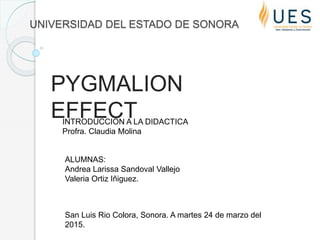
Pigmalion effect
- 1. UNIVERSIDAD DEL ESTADO DE SONORA PYGMALION EFFECTINTRODUCCION A LA DIDACTICA Profra. Claudia Molina ALUMNAS: Andrea Larissa Sandoval Vallejo Valeria Ortiz Iñiguez. San Luis Rio Colora, Sonora. A martes 24 de marzo del 2015.
- 2. INTRODUCTION The work of Rosenthal and Jacobsen (1968), among others, shows that teacher expectations influence student performance. Positive expectations influence performance positively, and negative expectations influence performance negatively. Rosenthal and Jacobson originally described the phenomenon as the Pygmalion Effect. “When we expect certain behaviors of others, we are likely to act in ways that make the expected behavior more likely to occur.” (Rosenthal and Babad, 1985)
- 3. PYGMALION EFFECT The Pygmalion effect refers to the phenomenon in which the greater the expectation placed upon people the better they perform. Is a form of self-fulfilling prophecy, and, in this respect, people will internalize their negative label, and those with positive labels succeed accordingly. Source: Boundless. “Teachers' Expectations.” Boundless Sociology. Boundless, 14 Nov. 2014. Retrieved 24 Mar. 2015 from https://www.boundless.com/sociology/textbooks/boundless-sociology- textbook/education-13/the-symbolic-interactionist-perspective-102/teachers-expectations-577-9627/
- 4. PYGMALION RESEARCH IN THE CLASSROOM The Pygmalion effect was famously applied to the classroom in the Rosenthal-Jacobson study, published in 1968. In this study, Robert Rosenthal and Lenore Jacobson showed that if teachers were led to expect enhanced performance from some children, then the children did indeed show that enhancement.
- 5. EXPERIMENT Focused on an experiment at an elementary school where students took intelligence pre-tests. Informed the teachers of the names of twenty percent of the students in the school who were showing “unusual potential for intellectual growth” and would bloom academically within the year. Unknown to the teachers, these students were selected randomly with no relation to the initial test. Tested the students eight months later, they discovered that the randomly selected students who teachers thought would bloom scored significantly higher.
- 6. Teacher expects a specific behavior from specific student. Because of these expectations, teacher behaves differently toward student. This treatment tells student what behavior teacher expects from them. If the treatment is consistent, it will shape the student’s behavior over time. Students’ behavior will conform more and more closely to teachers expectation of them. TEACHER EXPECTANC Y EFFECT
- 7. TEACHER EXPECTANCY EFFECT Teachers usually have higher expectations for students they view as higher achievers and treat these students with more respect. For example, studies have found that when students are split into ability- based groups, the students in the higher- ability groups are more likely to demonstrate positive learning behaviors and higher achievement. Source: Boundless. “Teachers' Expectations.” Boundless Sociology. Boundless, 14 Nov. 2014.
- 8. Teachers' expectations may also be gendered, perhaps explaining some of the gender achievement gap. Gender stereotyping within classrooms can also lead to differences in academic achievement and representation for female and male students. Source: Boundless. “Teachers' Expectations.” Boundless Sociology. Boundless, 14 Nov. 2014. Retrieved 24 Mar. 2015 from https://www.boundless.com/sociology/textbooks/boundless- sociology-textbook/education-13/the-symbolic-interactionist-perspective- TEACHER EXPECTANCY EFFECT
- 10. The Pygmalion effect is a theory teaching that people will act or behave in the way that others expect them to. The effect has both positive and negative outcomes — a person expected by his or her superiors to succeed will, but the opposite is also usually true. Most of the time, these expectations are not openly discussed. They are communicated passively through things like word choice or body language. SELF-FULFILLING PROPHECY
- 11. SELF-FULFILLING PROPHECY Body language is just as important as verbal communication when conveying both positive and negative expectations, as is tone of voice. The use of body language is most commonly a subconscious form of communication, but it can prove to be very powerful. The response and interpretation of non-verbal signals is also often subconscious but tends to be long-lasting, especially when referring to one person's expectations of
- 14. CONCLUSION People do better when more is expected from them. This means that we tend to need what is known as motivation to gain knowledge. There has been different types of studies that show the role of the teacher in these situations. As future teachers we should be aware of our role and how to handle this types of situations, we shouldn’t expect more from others, it is our job to treat everyone the same and not let anyone down. -Valeria Ortiz Iñiguez We have seen in our trayectory academic this situation I think many times, the teachers hope more of the students that they show more responsability, ignoring the other students, when the best thing they have do is motivate every one in the same way. - Andrea Larissa Sandoval Vallejo.
- 15. SOURCES Source: Boundless. “Teachers' Expectations.” Boundless Sociology. Boundless, 14 Nov. 2014. Retrieved 24 Mar. 2015 from https://www.boundless.com/sociology/textbooks/boundless- sociology-textbook/education-13/the-symbolic-interactionist- perspective-102/teachers-expectations-577-9627/ DUQUESNE UNIVERSITY, Murphy Building 600 Forbes Avenue 20 Chatham Square Pittsburgh, PA 15282 from http://www.duq.edu/about/centers-and-institutes/center-for- teaching-excellence/teaching-and-learning/pygmalion Boser Ulrich. “The Power of the Pygmalion Effect.” Center of American Progress. 06 Oct. 2015. Retrieved 23 Mar. 2015 from https://www.americanprogress.org/issues/education/report/2014/10/ 06/96806/the-power-of-the-pygmalion-effect/